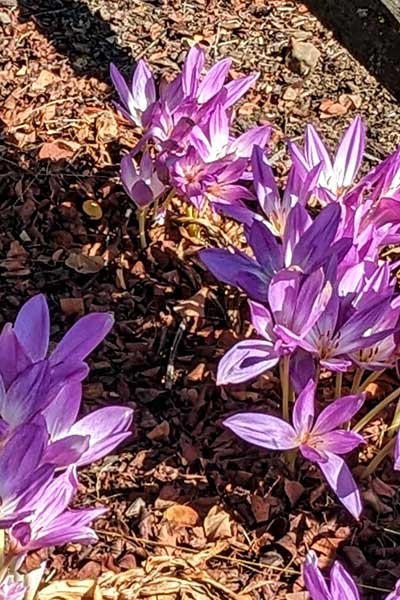Autumn Crocus
- Scientific Name: Colchicum autumnale
- Garden: Rain Garden
- Plant Type: Herbaceous Perennial
- Evergreen/Deciduous: Deciduous
- Sun/Shade Exposure: Full Sun
- Moisture Requirements: Moist, Well-Drained
Plant Information
This plant has high severity poison characteristics.
Colchicum autumnale, or Autumn Crocus, is a perennial herb with basal, slender leaves; long, tubular, 6 parted, purple-pink to white flowers that blossom in autumn (hence the common name). The flowers are very attractive to bees and butterflies. Native to southern Europe, Autumn Crocus can be found in meadows and damp woodland clearings on calcareous and neutral soils.
Autumn crocus prefers a rich, well-drained loam in a sunny position with a PH in the range of 4.5 to 7.5. It will tolerate partial shade and summer drought, but not dry soils. Plants are hardy to about -4 degrees F (-20°C) and the dormant bulbs are fairly hardy and will withstand soil temperatures down to at least 23 degrees F (-5°C). Autumn crocus are typically planted from corms, which should be planted about 2 3/4 to 4 inches (7 - 10cm) deep. Divide the bulbs in June or July when the leaves have died down. Larger bulbs can be planted out direct into their permanent positions. Pot up the smaller bulbs and grow them on in a cold frame for a year before planting them out. The plant can be divided every other year for a quick increase. The Autumn crocus is also easily grown in grass and can be naturalized there, among shrubs, and by woodland edges. When grown from seed, the seedlings take 4 to 5 years to reach flowering size. The plants seem to be immune to damage from rabbits.
Diseases, Insect Pests, and Other Plant Problems:
No serious diseases. Slugs may attack the corms. Fungal smut may attack the leaves. Poisonous and poses a particular threat to cats.
Data Source
https://plants.ces.ncsu.edu/plants/colchicum-autumnale/Plant Photos





